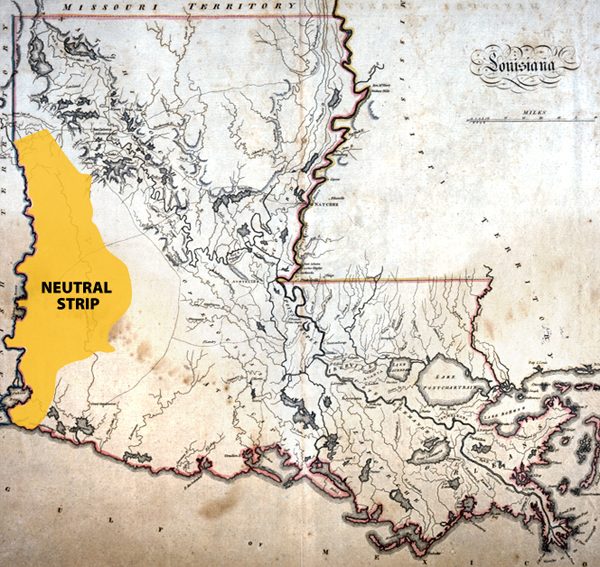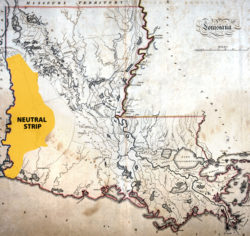Neutral Strip
The Neutral Strip existed outside the governance of either the United States or Spain until 1821.

Courtesy of Louisiana State Museum.
This map from 1814 shows Louisiana with the Neutral Strip highlighted.
The Neutral Strip, sometimes referred to as no-man’s-land or the neutral ground, was a disputed swath of territory lying between Spanish Texas and the newly American territory of Louisiana. In October 1806 US armed forces and the declining empire of Spain faced each other across the Sabine River. In an effort to avoid war, General James Wilkinson, in command of American forces, and Lieutenant Colonel Simón de Herrera, commanding for Spain, reached a temporary compromise known as the “neutral ground agreement.” If Herrera kept Spanish forces west of the Sabine, Wilkinson would withdraw American troops to the east of the traditional French/Spanish boundary. The two men formalized the establishment of the Neutral Strip in writing, agreeing that neither government would attempt to assert sovereignty over the area, send troops into the neutral territory, or allow anyone (not already resident) to enter until international diplomacy provided a final resolution to the boundary question. In effect, the neutral ground existed outside the governance of either the United States or Spain until 1821.
Uncertain Boundaries of Louisiana
After the United States acquired Louisiana from France, a dispute over the exact boundaries of the Louisiana Purchase brought Spain and the United States to the brink of war. Americans flocking to the western portion of Orleans Territory, and claiming Texas as part of the purchase, threatened the sparsely populated and poorly defended Spanish province. Exacerbated by tensions over relations with Native Americans, Spanish protection of people who had fled slavery, and the interruption of commercial ties between Natchitoches and Nacogdoches, each nation braced for conflict, rushing men to the border in the belief that invasion from the other was imminent.
The question of the official boundary between Louisiana and Texas hinged on Spain and France’s failure to officially settle the issue prior to 1763. Instead, the Spanish commander at the presidio of Los Adaes and the French commandant at Natchitoches reached a gentleman’s agreement. They established a dividing line from the Gulf of Mexico, between the Calcasieu and Mermenteau Rivers, to the Arroyo Hondo, then north to the vicinity of Natchitoches and up the Red River. When France ceded Louisiana to Spain, the boundary question became an internal one. The Spanish provincial governor of Cuba, responsible for Louisiana, and the governor of the Internal Provinces, responsible for Texas, accepted the dividing line between Louisiana and Texas. Following the United States’ purchase of Louisiana, US officials, including President Thomas Jefferson, argued that the Rio Grande constituted the boundary of the Louisiana Purchase. Many Americans, eager for territorial expansion, echoed this claim to the province of Texas.
The neutral ground agreement gave neither the United States nor Spain a solution to the boundary issue. At best it ameliorated the situation. Yet in the absence of an international treaty, it served all parties concerned. In the broader context of relations between nations, the compromise provided an extraordinary and valuable insight into the unique role that the Louisiana-Texas borderlands played in reshaping political and diplomatic practices. Far removed from the seats of power, leaders on both sides of the Sabine broke with convention to find a peaceful solution to a number of critical issues in a situation where normal diplomatic channels failed. By concluding the agreement as they did, Wilkinson and Herrera also removed, for practical purposes, any US effort to include Texas as part of the Louisiana Purchase by shifting the focus of negotiations from the Rio Grande to the Sabine. Most important, both the United States and Spain accepted the agreement, which served to reopen diplomatic talks between the two. In a very real sense, local diplomacy triumphed where international diplomacy failed, providing unique solutions to a complex set of problems at the border of empires as Spain and the United States dealt with a changing paradigm where neither held unchallenged control.
Lawless Land
While the agreement about the neutral ground prevented war, it proved more idealistic than practical, destabilizing the region for more than a decade. American squatters began moving into the area almost immediately after the zone became demilitarized. Runaway slaves, deserters from both armies, thieves preying on the trade along the Camino Real (Royal Road), and criminals found this region—outside of the control of governments or law—an ideal refuge. By 1808, the presence of these interlopers began to threaten seriously the regional stability that the agreement sought to achieve. As the number of bandits grew, trade along the Royal Road suffered. Merchants in Natchitoches and Nacogdoches complained to their local officials. As Americans unhappy with the exclusion of Texas from the Louisiana Purchase saw the possibilities of empire across the Sabine, the area became a staging ground for filibusters and revolutionaries. Conditions became especially ripe for the invasion of Texas after revolution broke out throughout Spain’s colonial empire in the Americas. Capitalizing on this opportunity, American filibusters converged on Spanish domains. For the people on both sides of the neutral ground, these international intrigues brought death, destruction, and economic hardship.
Realizing the gravity of the circumstances, yet understanding that the solution required diplomatic finesse, Texas’s Governor Manuel Salcedo wrote to Judge John Carr, justice of the peace in Natchitoches, suggesting a joint effort between the two nations to clear the neutral ground of all unauthorized persons. Judge Carr, a civil judge, found the idea appealing but deferred the decision to William C. C. Claiborne, governor of Orleans Territory.
Spanish-American Military Cooperation
Military leaders on both sides of the Sabine understood the necessity for cooperative, decisive action. Lacking a timely response from the American civil authority, Bernardo Bonavía, deputy commandant general of Texas, appealed to the American commander at Natchitoches. Noting that military officers, not civil authorities, had negotiated the neutral ground agreement, Bonavía asserted that enforcing it represented a question of honor among officers on the border. Concerned that continuing delays might negate this opportunity and perhaps provoke the Spanish to unilateral action, Colonel Thomas Cushing at Fort Claiborne entreated the secretary of war for permission to proceed. With the secretary’s tacit approval, Cushing dispatched fifteen men, under Lieutenant William Augustus Magee, into the neutral ground to join the commandant of Nacogdoches, José María de Guadiana, and an identical number of Spanish troops, to drive out the squatters, bandits, and deserters. During a two-week foray extending as far north as Bayou Pierre, the combined force destroyed a dozen buildings and compelled thirty-four people to leave.
As soon as the combined force vacated the neutral ground, undesirables filtered back into the region. By early 1812 the problem again required action. Commanding the US military in Orleans Territory, General Wade Hampton sent a force under Lieutenant Colonel Zebulon Pike to Natchitoches with orders to contact the Spanish at Nacogdoches and again form a joint expedition to clear the region of unauthorized persons. The Spanish commandant, uncertain of his authority, replied that he would correspond with the provincial governor for permission. Pike wasted no time in informing Nacogdoches that, with or without Spanish cooperation, he intended to send an American force into the neutral ground.
On March 5, Pike ordered William Augustus Magee, who had led the American contingent in 1810 into the ungoverned zone. The expedition destroyed eleven houses along with various tent camps they encountered. In the process, they captured sixteen men and thirty-five horses and mules, and recovered stolen merchandise, arms, and ammunition. This unilateral violation of the neutral ground agreement ended Spanish–American cooperation along the borders of Texas and Louisiana. Focusing on war with the British, American officials diverted their attention from the east and south, leaving the people on both sides of the border to suffer constant depredations.
Adams-Onís (Transcontinental) Treaty of 1819
In a final twist, the neutral ground became the means by which the United States wrested control of Florida from Spain. Article II of the Adams-Onís Treaty, also called the Transcontinental Treaty, of 1819 transferred all Spanish lands east of the Mississippi, specifically East and West Florida, to the United States. Article III established the western boundary of the American republic at a line beginning at the mouth of the Sabine River, continuing up the west bank north to the Red River, then following the west bank of the Red River to the Arkansas—effectively, though temporarily, conceding any American claim to Texas.
